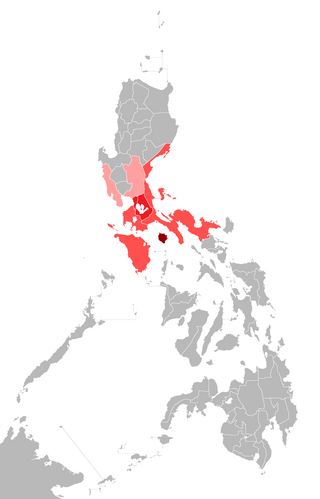Tagalog language
Austronesian language spoken as a first language by the ethnic Tagalog people From Wikipedia, the free encyclopedia
Tagalog[3] is one of the main or major local and regional languages in the Philippines, and it is "in practice" but not "according to the law" the basis, foundation or core of the current national language and one of the two official languages of the Philippines, which is named, declared and called as the Filipino language. More than 22 million people speak Tagalog as their first language.
| Tagalog | |
|---|---|
| Wikang Tagalog | |
| Native to | Philippines |
| Region | Katagalugan or Central to Southern Luzon; or in Metro Manila, Parts of Central Luzon, Most of Calabarzon, Parts of Mimaropa, and Northwestern Bicol |
| Ethnicity | Tagalog people |
Native speakers | 28 million (2007)[1] 96% of the Philippines can speak Tagalog (2000)[2] |
Austronesian
| |
Standard forms | Filipino
|
| Dialects |
|
| Latin (Abakada/Filipino); Baybayin (Revitalizing) | |
| Official status | |
Official language in | Philippines (in the form of Filipino) |
Recognised minority language in | Philippines (as a regional language and an auxiliary official language in the predominantly Tagalog-speaking areas) |
| Regulated by | Commission on the Filipino Language |
| Language codes | |
| ISO 639-1 | tl |
| ISO 639-2 | tgl, fil |
| ISO 639-3 | tgl – inclusive codeIndividual code: fil – Filipino |
| Linguasphere | 31-CKA |
 Predominantly Tagalog-speaking regions in the Philippines. The color-schemes represent the 4 dialect zones of the language: Northern, Central, Southern, and Marinduque. In addition, Tagalog is used as a second language across the entire country, especially in the form of Filipino. | |
It (the Tagalog language) was originally spoken by the Tagalog people in the Philippines, who were mainly in most of the Central to Southern parts of Luzon, which is the northern island group of the Philippines.
Now, Tagalog is spoken nationwide and used by other Filipinos as a second language and by most Filipinos from different parts of the Philippines to understand each other in the form of the official and national language named, declared and called the Filipino language.
The Filipino language is a language that continues to undergo evolution and development from the Pilipino language since 1987, and it has more language influences from the other languages of the Philippines and from foreign languages compared to the core Tagalog language.
The Pilipino language, since 1959, is the last or final official name of the former or previous official and national language of the Philippines based on the Tagalog language, all before Filipino was later named and declared to be the new and future national language of the Philippines, and also all before Filipino was later named and declared as the national language and one of the two official languages of the Philippines, with the English language on that last part.
It originally was used with an abugida writing system, the Baybayin script, but the Latin script or alphabet is now used, especially the former or previous Abakada (alphabet) with 25 letters and the current (Modern) Filipino alphabet with 28 letters.
Sample phrases
- Magandang Umaga! - Good Morning!
- Magandang Gabi! - Good Evening!
- Magandang Tanghali! - Good Afternoon!
- Kumusta!/Kamusta? - How are you?/Hello! (Informal)
- May ______ ba kayo? - Do you have ______?(Formal)
- Mayroon po: Response to "May ______ ba kayo", meaning "Yes, sir".
- Wala po - Opposite of "Mayroon po".
- Kayo - you (formal), informally, it refers to "you all".
- Magkano ito? - How much is this?
- po: ma'am or sir (used in sentences to be polite to an elder speaker)
- Mabuhay! - Long Live
- Ako po si (Pangalan)... - I am (Name)...
- Mahal kita - I love you
- Nanay - Mom
- Tatay - Dad
- Hindi - No
- Bakit? - Why?
- Saan? - Where?
- Ano? - What?
- Kailan? - When?
- Sino? - Who?
Related pages
References
Other websites
Wikiwand - on
Seamless Wikipedia browsing. On steroids.
